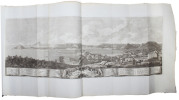2 books for « paoli paolo antonio »Edit
-
Countries
Denmark (1)
Italy (1)
Antichita di Pozzuoli. Puteolanae antiquitates. Avanzi delle antichita esistenti a Pozzuoli, Cuma e Baja. Antiquitatum Puteolis, Cumis Balis existentium reliquiae. - [A MASTERPIECE OF 18TH CENTURY ITALIAN CHALCOGRAPHY]
(Napoli, 1768). Folio. Bound uncut in a magnificent recent sprinkled full calf pastiche-binding with seven raised bands, forming eight compartments. Two leather title-labels to spine and compartments and raised bands with gilt ornamentation. All edges of boards with blindstamped decorations. One text leaf (unnumbered, but no. 38) with small stain and one diagram with tiny hole measureing 1 cm2, both far from affecting text/plate, very light soiling to first two leaves. All in all a very fine, clean an attractive copy. Complete with 39 ff. of text [Italian and Latin in parallel columns], 69 plates of views and diagrams of which three are double page and one folded, a beautiful panorama depicting the Bay of Pozzuoli ('Veduta della Costa di Pozzuoli').
The rare first edition of Paoli's masterpiece of 18th century Italian chalcography with both text and views in beautiful copper engraved plates. The systematic documentation of classical ancient Greek and Roman ruins, many of which are here depicted for the very first time, is considered the most important eighteenth century views of Pozzuoli and its surroundings. The engravings by Giovanni Volpato, Antoine Cardon, Francesco La Marra, and Johann Dominik Fiorillo are based on drawings by local artists such as Gianbattista Natali, Tommaso Rojola, Ricciarelli and Magri. Conte Felice Gazzola commissioned the present work and when published, it was printed in very few copies only and sold for 15 Neapolitan ducats. A second edition in folio-oblong was printed in 1769.Pozzuoli, located just north of Naples, began as a Greek colony and a Roman colony was established in 194 BC. Pozzuoli (at the time named Puteoli) was the great emporium for the Alexandrian grain ships and other ships from all over the Roman world. It was also the main hub for goods exported from Campania, including blown glass, mosaics, wrought iron, and marble. The Roman naval base at nearby Misenum housed the largest naval fleet in the ancient world. It was also the site of the Roman Dictator Sulla's country villa and the place where he died in 78 BC - the ruins of many of these sights are portrayed in the present work. Paolo Antonio Paoli, president of the Pontifical Ecclesiastical Academy in Rome (1775-98), was a pioneering scholar and historian of the ancient civilizations of the region of Campania in southern Italy. Cicognara 2692 (erroneously dated 1778)Graesse I, 146 Brunet I, 314
ANTICHITA DI POZZUOLI. AVANZI DELLE ANTICHITA ESISTENTI A POZZUOLI CUMA E BAIA.
Antiquitatum Puteolis Cumis Baiis Existentium Reliquiae. s.l.(ma Firenze), 1768. In folio, piena pelle coeva, dorso a cordoni con fregi e titolo oro su tassello (picc. manc. alla cuffia inferiore), 36 fogli di testo italiano e latino (spiegazione delle tavole), inquadrati e interamente incisi, 2 cc.nn. dIndice e 69 tavole fuori testo (di cui 3 a doppia pagina e 1 più volte ripieg.), numerate I-LXVIII + una tavola numerata XLII bis, comprendenti lantiporta, il frontespizio e la dedica a Ferdinando IV con figure allegoriche e ritratto del Re e della Regina in medaglione. Le bellissime tavole, che contengono vedute di rovine e piante delle località che si trovavano sullantica via Campana, sono magnificamente incise da noti artisti quali: Giovanni Volpato, Antoine Cardon, Francesco La Marra, C.R. Nicole, N. Fioritto e N. Mogalli; dai disegni di artisti locali quali Gianbattista Natali, Tommaso Rojola, Ricciardelli, Magri, Filippo Falciatore e dallo stesso La Marra. In particolare si segnala la grandissima, stupenda Veduta della Costa di Pozzuoli."Rara prima edizione" di questo capolavoro della calcografia italiana del XVIII secolo.Cfr. Fera-Morlicchio,II,673: Superba opera per il suo aspetto editoriale e per il contenuto iconografico interamente inciso su rame. E da considerarsi certamente una delle più ammirevoli composizioni del secolo XVIII.. Rarissima ed artistica opera settecentesca. Cfr. anche Borroni,7735 - Brunet,I,314 - Graesse,I,146 - Cicognara,2692 (erroneamente datato 1778) - Berlin Kat.,1895.Documentazione sistematica delle rovine classiche greche e romane antiche, molte delle quali sono qui raffigurate per la prima volta. Il conte Felice Gazzola commissionò la presente opera e quando fu pubblicata venne stampata solo in pochissime copie e venduta per 15 ducati napoletani; una seconda edizione in folio fu stampata nel 1769. Paolo Antonio Paoli, presidente della Pontificia Accademia Ecclesiastica di Roma (1775-98), fu uno studioso e storico pioniere delle antiche civiltà della regione della Campania nell'Italia meridionale.Esemplare con la cerniera interna leggermente allentata, altrimenti ben conservato, ad ampi margini.
 Write to the booksellers
Write to the booksellers




